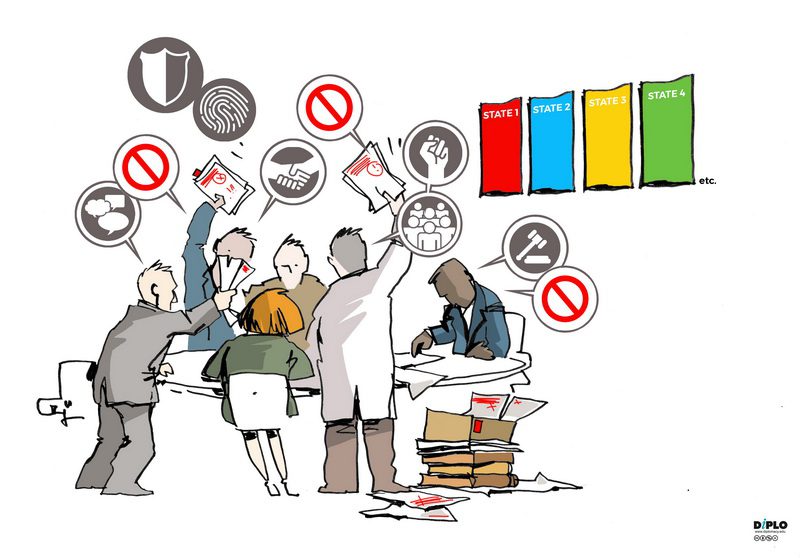The UN’s Ad Hoc Committee to Elaborate a Comprehensive International Convention on Countering the Use of ICTs for Criminal Purposes aka the Ad Hoc Committee on Cybercrime convened in New York for a culminating session held from 29 January to 9 February 2024, marking the end of two years of negotiations. The Ad Hoc Committee (AHC) was tasked with drafting a comprehensive cybercrime convention. However, as the final session started, there were no signs of significant progress: member states couldn’t agree on significant issues such as the scope of the convention. As a result, the delegations required more time to discuss the content and wording of the draft convention and decided to hold additional meetings. Though some delegations such as China and the US offered financial support for more meetings, several states such as El Salvador, Uruguay, and Lichtenstein pointed out the strain these additional meetings would put on their resources.

The chair initially split negotiations in two tracks: formal sessions and informal meetings behind closed doors. The informal meetings seem to have focused on more sensitive issues such as the scope and human rights-related provisions and were extremely intense causing the regular sessions to start late. It also resulted in less transparency in negotiations and excluded the multistakeholder community from contributing.
In the last days of the concluding sessions, there was increased pressure from civil society and the industry, as well as cybersecurity researchers.
So, what happened?
Here are the issues with the draft convention that need to be resolved:
Scope of the convention and criminalisation
One of the main unresolved points remains the question whether the cybercrime convention should be a traditional treaty or if it should cover all crimes committed via ICTs. This divide translated into a lengthy discussion on the name of the convention itself, as well as on Article 3 (scope of application) of the draft convention.
In relation to the scope of application, delegations discussed Canada’s proposal, which received support from 66 states. The proposal suggests wide wording of the actions that may fall within the scope of the convention, and adding Article 3.3 to ensure that the convention doesn’t permit or facilitate ’repression of expression, conscience, opinion, belief, peaceful assembly or association; or permitting or facilitating discrimination or persecution based on individual characteristics’.
The Russian Federation continued expressing the view that the AHC hadn’t fully implemented the mandated outline in Resolution 74/247 which established the committee, and the scope of the convention should include broader measures to combat ‘the spread of terrorist, extremist, and Nazi ideas with the use of ICTs’. Russia further highlighted that ‘many articles are simply copied from treaties that are 20 years old’ and that the revised text doesn’t include efforts to agree on procedures of investigation, or creating platforms and channels for law enforcement cooperation.
In the same vein, Iran, Egypt, and Kuwait see the primary mandate of the AHC to elaborate a comprehensive international convention on the use of ICT for criminal purposes and see the inclusion of human rights regulations and detailed international collaboration as duplication of already existing international treaties.
Representatives from civil society, private entities, and academia also shared feedback on the scope, stressing the importance of limiting the convention’s scope and implementing strong human rights protections. They expressed concerns about the convention’s potential to undermine cybersecurity, jeopardise data privacy, and diminish online rights and freedoms.
Discussing additional provisions in the criminalisation chapter, delegations were deadlocked over specific terms. For instance, concerning Article 6(2), 7(2), and 12, Russia, with support from several delegations, proposed replacing ‘dishonest intent’ with a more specific term. Russia’s representative argued that ‘dishonest’ is not a legal term, thus making it challenging for countries to implement or clarify it in domestic legislation. However, the UK, US, and EU opposed this change. Austria, in particular, explained that ‘dishonest intent’ provides clear criteria for identifying when conduct constitutes an offence, offering flexibility across various legal systems.
Human rights and safeguards
Human rights (Article 5) and safeguards (Article 24) have been a difficult topic for delegations from day one. Some delegations such as Iran argued that the cybercrime treaty is not a human rights treaty, suggesting a model akin to the UN Convention against Corruption (UNCAC), which omits explicit human rights references. As reported earlier, this didn’t find support from many other delegations.
Egypt and other delegations also expressed confusion over the repetitive nature of certain human rights provisions within the text, emphasising the redundancy of similar mentions occurring five or six times.
Additionally, Egypt raised concerns about Article 24 and questioned why the principle of proportionality was singled out from other legal principles recognised under international law. Egypt pointed out the challenge of applying proportionality when different countries have varying legal provisions, such as the death penalty. Pakistan supported Egypt and Brazil suggested appending ‘legality’ to the principle of proportionality, including both of the principles of legality and proportionality. Ecuador expressed support for Brazil’s proposal.
As a result, both articles remain without text in the further revised draft text of the convention.
There was no consensus regarding the articles on online sexual abuse (Article 13) and non-consensual distribution of intimate images (Article 15). Delegations tried to find a balance between protecting privacy and criminalising the sharing of intimate images without consent. Many felt the convention should be flexible to accommodate different laws and international human rights agreements. There was debate about whether to stick with the Convention on the Rights of the Child’s (CRC) definition or use a different one. The US worried the CRC’s definition didn’t fit cybercrimes well and might lead to inconsistent interpretations that wouldn’t adequately protect children under Article 13.
Transfer of technology and technical assistance
The transfer of technology appears twice in Article 1 (statement of purpose) and Article 54 (technical assistance and capacity-building). The group of African countries strongly advocated for keeping a reference to the transfer of technology in both articles, including in Article 1, paragraph 3.
Russia, Syria, Namibia, India, Senegal, and Algeria supported this, while the US was against it and called to keep this reference in Article 54 only. The EU, Israel, Norway, Canada, Albania, and the UK supported the US.
With Article 54, more or less the same groups of states had further disagreements. The US, Israel, the EU, Norway, Switzerland, and Albania supported inserting ‘voluntary’ before ‘where possible’ and ‘on mutually agreed terms’ in the context of how capacity building shall be provided between states in Article 54(1). Most African countries and Iran, Iraq, Cabo Verde, Colombia, Brazil, and Pakistan, opposed such a proposal because it would undermine the purpose of the provision in ensuring effective assistance to developing countries. With the goal of reaching a consensus on Article 54(1), the US withdrew its proposal and retained the ‘where possible’ and ‘mutually agreed terms’. In the revised draft text of the convention these paragraphs remain open for further negotiations between delegations.
Scope of international cooperation
Delegations expressed opposing views on provisions related to cooperation on electronic evidence and didn’t reach consensus. The discussion included Articles 35 (1) c, Article 35 (3), and (4), which deal with the general principles of international cooperation and e-evidence. The draft convention allowed countries to collect data across borders without prior legal authorisation. However, there were no agreements across many delegations.
In particular, New Zealand, Canada, the EU, Brazil, the USA, Argentina, Uruguay, Singapore, Peru, and others expressed concerns: fearing that the current draft of Article 35 would allow an excessively broad application, potentially leading to the pursuit of non-criminal activities. These states expressed views that the previous draft allowed for national law to determine what constitutes criminal conduct and pointed out the need to differentiate between serious crimes and offence, the need for safeguards and guardrails on the power of states to limit the possibility of repression and implementations of intrusive and secret mechanisms and to ensure the protection of human rights. On the other hand, states like Egypt, Saudi Arabia, Iran, Iraq, Mauretania, Oman, and others called for the deletion of Article 35 (3) altogether.
Additionally, New Zealand suggested including a non-discrimination clause in Article 37(15) on extradition to prevent unfair grounds for refusing cooperation. This would ensure consistency across the entire chapter on international cooperation. However, member states couldn’t agree on the language and left this open.
Within the international cooperation chapter, delegations spend quite a bit of time discussing the terms: in particular, in Article 45 and 46 the debates centred around the use of ‘shall’ vs ‘may’. The EU and other delegations advocated for changing ‘shall’ to ‘may’ in those articles to allow states the option, but not the obligation, to cooperate. This proposal was met with mixed reactions, with some delegations, including Egypt and Russia preferring to retain ‘shall’ to ensure robust international cooperation. The countries opposing the change from shall to may advocate that this would undermine the effectiveness of the cooperation between the states. So far, the further revised draft text of the convention includes both options in brackets.

Preventive measures
Another term which created some confusion across several delegations was the use of ‘stakeholders’ in Article 53, where preventive measures are discussed and paragraph 2 highlights that ‘States shall take appropriate measures […] to promote the active participation of relevant individuals and stakeholders outside the public sector, such as non-governmental organizations, civil society organizations, academic institutions and the private sector, as well as the public in general, in the prevention of the offences covered by this Convention’. Egypt, in particular, called to remove the word ‘stakeholders’ unless it’s clearly defined. The US didn’t support this proposal. The further revised draft text of the convention ‘relevant individuals and entities […]’, but the paragraph hasn’t been agreed yet.
In the same article, in paragraph 3(h), where ‘gender-based violence is mentioned and strategies and policies should be developed to prevent it, states couldn’t reach an agreement. The first group of states, including the USA, Iceland, Australia, Vanuatu, and Costa Rica, advocated for keeping the provision. Other delegations such as Iran, Namibia, Saudi Arabia, and Russia, among others, proposed the deletion of the term ‘gender-based’ and instead keep ‘violence’. In the end, this part remained as it is with the term ‘gender-based violence’, with the chair emphasising that this article is not obligatory as it says that preventing measures may include.
Another notable example of where states had opposing views was Article 41 on 24/7 network, which is a point of contact designated at the national level, available 24 hours a day and 7 days a week, to ensure the provision of immediate assistance for the purposes of the convention. India proposed new duties for the 24/7 network, explaining that prevention should be a part of such duties. They particularly stressed that ‘if the offence is not prevented and it occurs, States would be needing multiple times the resources that they saved in the process of evidence collection, prosecution, extradition, and so on. So it’s better to prevent rather than to spend multiple times the same resources that States are trying to save in going through the whole process of criminal justice’. Russia, Kazakhstan and Belarus supported this proposal, while the US, UK, Argentina, the EU, and Canada didn’t.
So, what’s next?

As mentioned earlier, the delegates managed to agree on one major item to postpone the final decision. The chair’s further revised draft text of the convention is available at the AHC’s website, and new dates for more meetings should be announced soon.
Does this mean that delegations are close to reaching a consensus over a landmark cybercrime convention before the UN General Assembly? Hardly so, but these two weeks have also demonstrated that many (though less fundamental compared to the scope of application) open issues have been resolved behind closed doors, and there is still a chance that intense non-public negotiations between delegations could speed up the process.
We will continue to monitor the negotiations, in the meantime discover more through our detailed reports from each session generated by DiploAI.





























